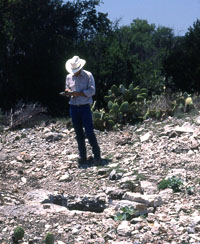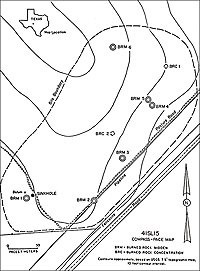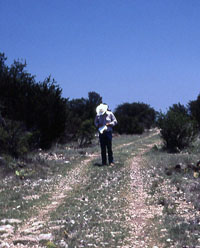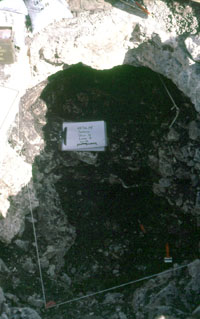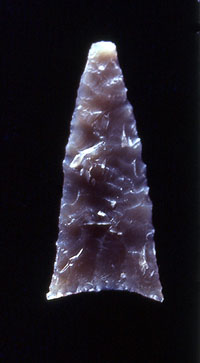Mittel Site
This fascinating site contains a small sinkhole cemetery and six burned rock middens.Located about 30 miles south of San Angelo in north-central Schleicher County, the Mittel site (41SL15) is a welcome exception to the general dearth of well documented archeological sites on the western Edwards Plateau. Unlike most other sinkhole cemeteries known in the region, the one at the Mittel site is located side-by-side with a rather ordinary work place—a plant baking facility, known to archeologists as a burned rock midden.
The sinkhole cemetery was found by accident when the landowner attempted to eradicate a rattlesnake den inside the natural hole in the limestone bedrock. Clearing out the hole to make sure he had finished off the snakes, the rancher discovered human bones, bones he could plainly tell were very old. He called in archeologists from the Texas Archeological Research Laboratory to investigate. A small group of researchers and archeology students led by Darrell Creel carried out extensive survey and limited excavations in 1988 and 1989 at the Mittel site. Within the narrow confines of the sinkhole, they documented the remains of at least five individuals dating to the latter part of the Late Prehistoric period (after A.D. 1300).
The layering of the sinkhole deposits indicate that the human remains were interred after the formation of the adjacent burned rock midden, but it is not known if this midden or others nearby were still in use at the time of the burials. As explained in more detail in the Camp Bowie exhibit, burned rock middens are specialized plant-baking facilities. The juxtaposition of an ordinary work place and a special place where loved ones were buried is probably more an accident of nature rather than a purposeful choice. Clearly, the area had a concentration of the targeted baking plants; while the Mittel middens were not excavated, we know from other sites in the general region that the targeted plants may have included prickly pear cactus, sotol, yucca, and wild onions.
The Mittel site is an excellent example of cooperation between private landowners and professional archeologists. Data recovered from the site has the potential to tell us a great deal about economic patterns, social organization, and changes in how people used the landscape use over prehistoric time on the western Edwards Plateau.
